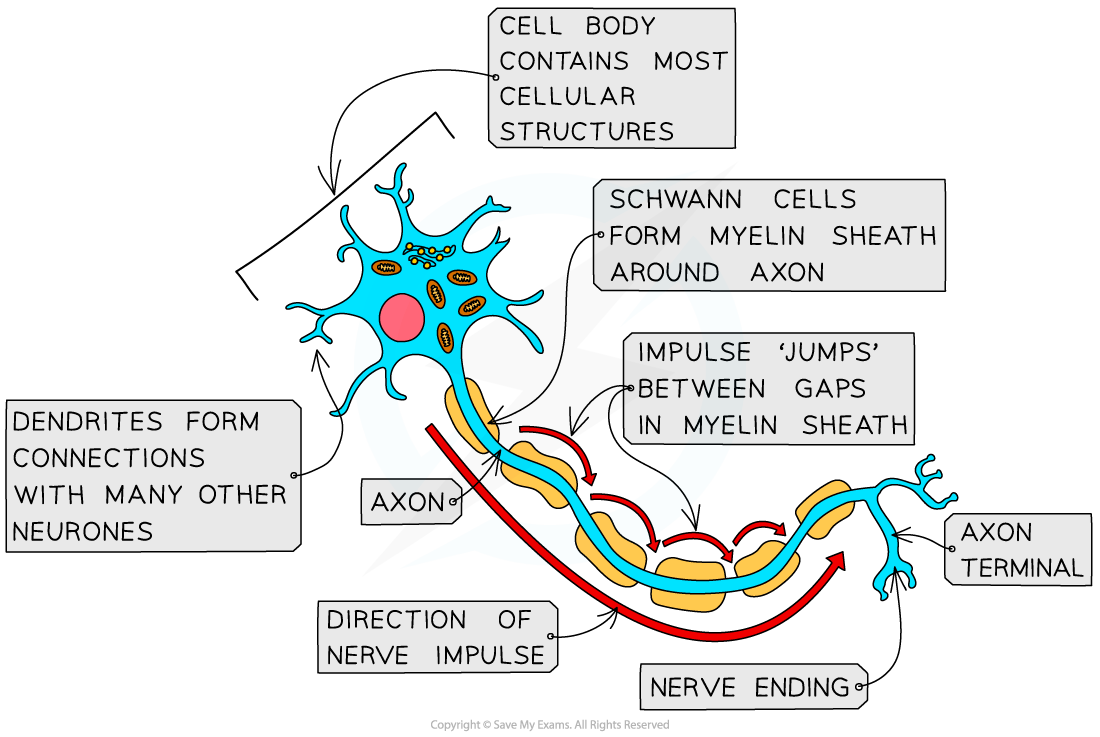Neurones (Cambridge (CIE) A Level Biology)
Revision Note
Neurones
A neurones has a long fibre known as an axon
The axon is insulated by a fatty sheath with small, uninsulated sections along its length (called nodes of Ranvier)
The sheath is made of myelin, a substance that is made by specialised cells known as Schwann cells
Myelin is made when Schwann cells wrap themselves around the axon along its length
This means that the electrical impulse does not travel down the whole axon, but jumps from one node to the next
This means that less time is wasted transferring the impulse from one cell to another
Their cell bodies contain many extensions called dendrites
This means they can connect to many other neurones and receive impulses from them, forming a network for easy communication
A Myelinated Neurone Diagram

An example of a neurone
There are three main types of neurone: sensory, relay and motor
Sensory neurones carry impulses from receptors to the CNS (brain or spinal cord)
Intermediate (aka relay) neurones are found entirely within the CNS and connect sensory and motor neurones
Motor neurones carry impulses from the CNS to effectors (muscles or glands)
The Three Types of Neurone Diagram

The three types of neurone – the red line shows the direction of impulses. Note that axons always carry nerve impulses away from the cell body
Each type of neurone has a slightly different structure
Motor neurones have:
A large cell body at one end, that lies within the spinal cord or brain
A nucleus that is always in its cell body
Many highly-branched dendrites extend from the cell body, providing a large surface area for the axon terminals of other neurones
Sensory neurones have the same basic structure as motor neurones, but have:
A cell body that branches off in the middle of the cell - it may be near the source of stimuli or in a swelling of a spinal nerve known as a ganglion
Reflex arc
Sensory neurones, intermediate (relay) neurones and motor neurones work together to bring about a response to a stimulus
A reflex arc is a pathway along which impulses are transmitted from a receptor to an effector without involving ‘conscious’ regions of the brain
As it does not involve the brain, a reflex response is quicker than any other type of nervous response
Examples of simple reflex actions that are coordinated by these pathways are:
Removing the hand rapidly from a sharp or hot object
Blinking
Focusing the eye on an object
Controlling how much light enters the eye
The Reflex Action Diagram

How sensory neurones, intermediate (relay) neurones and motor neurones work together to carry out a reflex action
In the example above:
A pin (the stimulus) is detected by a pain receptor in the skin
The sensory neurone sends electrical impulses to the spinal cord (the coordinator)
Electrical impulses are passed on to an intermediate neurone in the spinal cord
The intermediate neurone connects to the motor neurone and passes the impulses on
The motor neurone carries the impulses to the muscle in the leg (the effector)
The impulses cause the muscle (the quadriceps in this case) to contract and pull the leg up and away from the sharp object (the response)
The Pathway of a Reflex Arc Diagram

The pathway of a reflex arc
Examiner Tips and Tricks
You may be asked to identify the different types of neurone in a diagram. It can be helpful to memorise the key differences between them – such as the location and size of the cell body.

You've read 0 of your 5 free revision notes this week
Sign up now. It’s free!
Did this page help you?
